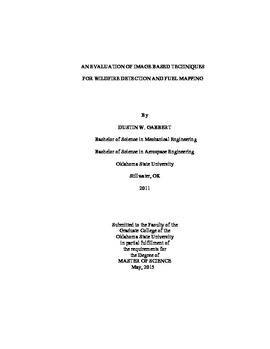| dc.contributor.advisor | Jacob, Jamey D. | |
| dc.contributor.author | Gabbert, Dustin W. | |
| dc.date.accessioned | 2016-09-29T18:34:36Z | |
| dc.date.available | 2016-09-29T18:34:36Z | |
| dc.date.issued | 2015-05-01 | |
| dc.identifier.uri | https://hdl.handle.net/11244/45167 | |
| dc.description.abstract | Few events can cause the catastrophic impact to ecology, infrastructure, and human safety of a wildland fire along the wildland urban interface. The suppression of natural wildland fires over the past decade has caused a buildup of dry, dead surface fuels: a condition that, coupled with the right weather conditions, can cause large destructive wildfires that are capable of threatening both ancient tree stands and manmade infrastructure. Firefighters use fire danger models to determine staffing needs on high fire risk days; however models are only as effective as the spatial and temporal density of their observations. OKFIRE, an Oklahoma initiative created by a partnership between Oklahoma State University and the University of Oklahoma, has proven that fire danger assessments close to the fire � both geographically and temporally � can give firefighters a significant increase in their situational awareness while fighting a wildland fire.This paper investigates several possible solutions for a small Unmanned Aerial System (UAS) which could gather information useful for detecting ground fires and constructing fire danger maps. Multiple fire detection and fuel mapping programs utilize satellites, manned aircraft, and large UAS equipped with hyperspectral sensors to gather useful information. Their success provides convincing proof of the utility that could be gained from low-altitude UAS gathering information at the exact time and place firefighters and land managers are interested in. Close proximity, both geographically and operationally, to the end can reduce latency times below what could ever be possible with satellite observation.This paper expands on recent advances in computer vision, photogrammetry, and infrared and color imagery to develop a framework for a next-generation UAS which can assess fire danger and aid firefighters in real time as they observe, contain, or extinguish wildland fires. It also investigates the impact information gained by this system could have on pre-fire risk assessments through the development of very high resolution fuel maps. | |
| dc.format | application/pdf | |
| dc.language | en_US | |
| dc.rights | Copyright is held by the author who has granted the Oklahoma State University Library the non-exclusive right to share this material in its institutional repository. Contact Digital Library Services at lib-dls@okstate.edu or 405-744-9161 for the permission policy on the use, reproduction or distribution of this material. | |
| dc.title | Evaluation of Image Based Techniques for Wildfire Detection and Fuel Mapping | |
| dc.type | text | |
| dc.contributor.committeeMember | Kidd, James A. | |
| dc.contributor.committeeMember | Mathews, Adam | |
| osu.filename | Gabbert_okstate_0664M_13961.pdf | |
| osu.accesstype | Open Access | |
| dc.description.department | Mechanical & Aerospace Engineering | |
| dc.type.genre | Thesis | |
